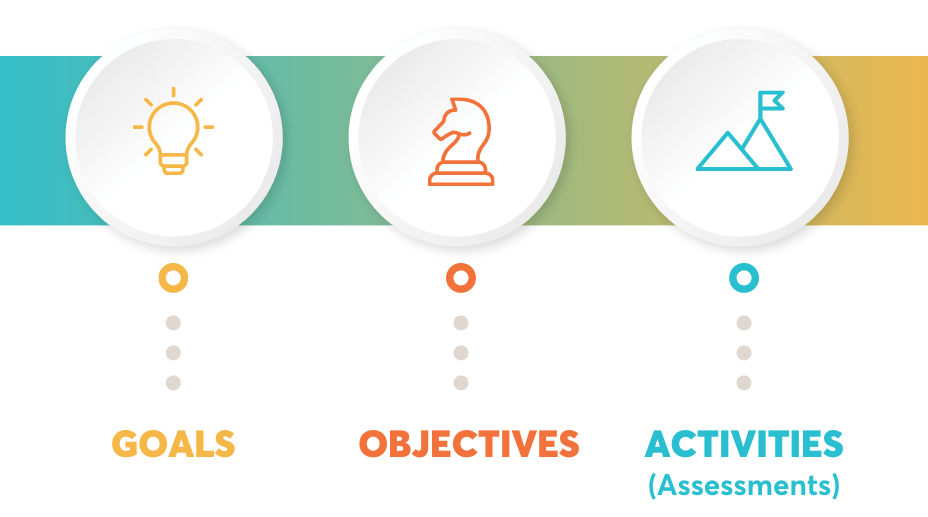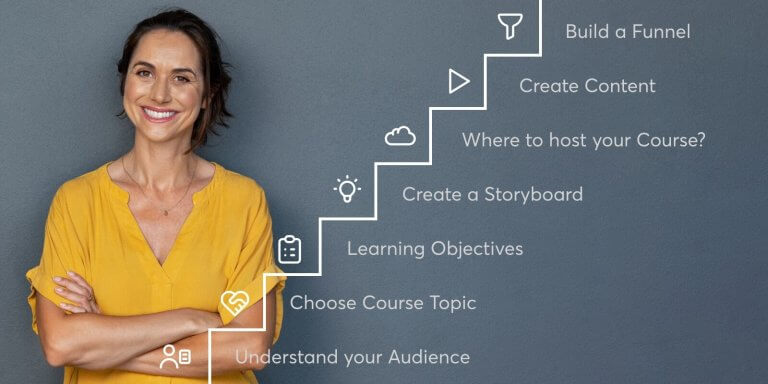Table of Contents
Thinking about creating an online training course and not sure where to start? You’re in exactly the right place.
Today, online training courses aren’t just about putting content online — they’re about building learning experiences that truly teach, inspire, and drive real transformation. Whether you’re training employees, helping people master new skills, or selling your professional expertise, an online training course gives you the opportunity to reach learners everywhere, at their own pace, in their own time.
I’ve seen firsthand, through my work with LearnWorlds, how a well-crafted online training course can launch careers, scale businesses, and change lives. And here’s the best part: you don’t need to be a tech wizard or a guru to make it happen. With the right tools, mindset, and step-by-step plan, you can create a high-quality course that stands out and delivers lasting value.
In this guide, I’ll walk you through every stage, from finding the right online course idea and building your course content, to choosing the best learning management system (LMS) and marketing your course to your ideal learners.
If you’re ready to create an online training course that’s built for success — not just launched and forgotten — let’s dive in.
What is an online course?
An online course is a structured program of lessons and activities delivered through a digital platform. The goal is to guide learners toward achieving specific learning outcomes through thoughtfully designed course content, activities, and assessments.
Most online courses today include high-quality video lessons, interactive elements such as quizzes and polls, downloadable resources, and vibrant online communities for learner engagement.
These courses are typically hosted on an online course platform or a learning management system (LMS) designed to facilitate online learning. A strong LMS will help you organize your course curriculum, manage learner progress, gather feedback, and create an engaging learning environment.
The rise of online education means that almost any subject with high market demand can become the foundation for a valuable course idea. Whether you offer a free course, a paid course, or an entire course series, there has never been a better time to create online courses and start selling courses globally.
The 11-step guide to course creation
Below are 11 steps to success, tested & tried.
Step 1. Think positive
Before you create an online training course, you need to get into the right mindset. Trust me — your success starts here.
It’s completely normal to have doubts when you’re building your first online course:
I’ve seen hundreds of course creators battle these fears and win.
Here’s the truth: you don’t need to know everything or have a perfect setup to get started. What matters most is your commitment to share valuable skills and make a difference.
Today’s course platforms and learning management systems (like LearnWorlds) are designed to make the process intuitive, even if you’re teaching online for the first time.
Plus, there’s never been a higher market demand for flexible, high-quality online education.
Pro tip: Focus on why you’re creating this course. Is it to help others? To scale your business? To make your knowledge accessible? Hold onto that purpose — it’ll guide you through every step ahead.
Step 2. Choose a course topic
If you’re knowledgeable about a topic that you love, be it a hobby or a job skill, then you already have a potentially profitable course idea on the table. People want to learn from someone who not only knows what they’re talking about but is also really passionate about it.
And how can you tell if the topic you have in mind is popular? Start your research from social media, especially Facebook groups and Reddit and Quora communities where people engage in discussions.
You can also search on course marketplaces for relevant topics and check the signup numbers to see which courses attract the audience the most.
For more e-course ideas, take a look at these:
Bonus tip: Start by validating your idea with a free course or a mini-series before building your entire course. This helps you gather feedback early, fine-tune your course material, and build momentum.
Step 3. Understand your audience
To appeal to your target audience and help your learners go from point A to point B, you need to know a few things about them. Important questions to ask:
Never assume that you have all these answers. Gauge social media, send out surveys, or even ask people in your circle that match the profile of your potential customers.
Remember: You’re not just creating content — you’re creating a learning experience.
Step 4. Write down your learning objectives
Learning objectives explain, with measurable verbs and with as much detail as possible, what the learner will be able to do by the end of the course.
Learning objectives are the equivalent of a value proposition, as they explain to potential customers the benefits they will gain from your course. For this reason, they should be mentioned in a prominent spot on your sales page.
Good learning objectives are:
Here’s an example: “By the end of this online training course, you’ll be able to design and deliver a 30-minute live session using professional-quality video content.”
Tip: Use your learning objectives later to shape your course curriculum, landing page, and marketing materials. They’re not just a teaching tool — they’re a powerful marketing tool too.
Why are learning objectives important?
Learning objectives are narrow and specific, as opposed to learning goals that are more long-term and broad. They’re directly linked to the expected results, and they can help the instructor build relevant assessments that will effectively measure whether the student has reached the desired learning outcomes of the course.

Step 5. Create a storyboard
Once your learning objectives are locked in, it’s time to map out the course outline.
Storyboarding your course is like drawing a treasure map — it helps you see the full learning journey before you build it. Without it, you risk ending up with a course that feels scattered or overwhelming.
Here’s how to create a simple but effective course storyboard:
Tip: Always design your storyboard with your learner’s journey in mind. Ask yourself: “Does this flow make it easier for my students to stay motivated and track their own learner progress?”
A strong storyboard is the backbone of a high-quality course — one that feels structured, engaging, and manageable for your learners.
We have also put together another invaluable resource you can download for free, the “Definite checklist to design your course contents.” Check it out before creating your course.
Step 6. Decide where you’ll host your online course
Once you have your course outline ready, it’s time to think about where you’ll upload your course material and sell it as a complete course offering.
In the e-learning market, you have three options:
Option 1: Self-hosting
Many people choose to self-host their course, especially if they already have a WordPress website. In this case, you’ll have to find an LMS plugin and multiple add-ons, so that you can create a course and website with full functionality – a process that can quickly become cumbersome and confusing.
Option 2: Online course marketplaces
Course marketplaces like Udemy have a massive reach, so this option will help you get some visibility fast. Plus, you don’t need to have any technical skills to upload and start selling your course.
On the downside, selling your course via a third party means you’ll give up a big percentage of your profit as marketplaces have a high fee per sale. Another downside is that they don’t support white labeling or customization, therefore, you can’t let your personal branding stand out.
Option 3: Online course platforms
Lastly, you can use a Learning Management System or course creation platform to host your online course, with LearnWorlds, Thinkific, Podia, Teachable, and Kajabi being among the most popular choices.
Why I recommend platforms like LearnWorlds:
Besides, platforms like LearnWorlds integrate paid advertising tools, affiliate program management, and marketing automations — giving you everything you need to grow without needing to piece together multiple software solutions.
Step 7. Create your content
Now it’s time to start creating your content. You need to be aware of instructional design basics for distance learning and the different ways you can deliver your course to ensure it is as engaging as possible.
For this reason, you should always have an instructional plan in mind. I have a few quick tips on that:
1. Small wins
Small wins are simple activities/challenges in your course that give your students a sense of accomplishment and confidence. They keep students excited about learning and refuel their motivation.
Include small wins throughout the course, and award your learners with badges and congratulatory pop-up messages every time they complete a challenge.
2. Scaffolding
Scaffolding is layering the learning experience, so students build on the concepts they already understand. Scaffolding requires that you gradually layer from simple concepts to more challenging ideas by telling students how this new information fits into what they already know. Keep in mind that scaffolding is an excellent way to prevent cognitive overload.
3. Active learning
It is not enough to include dozens of videos of yourself speaking into the camera or do a lot of screen recording. Learners must do something to learn, and they must interact with each other and you whenever possible.
Use quizzes, assignments, and interactive elements to transform learners from passive to active. Social activities like course discussions and live webinars and workshops are also incredibly effective and engaging.
At LearnWorlds, we have massive experience in course creation. This is why we have created 50 instructional design cards, which you can print out and use in your course creation. In this guide, you will find everything you need to know to provide appealing course content.
4. Video
Video is one of the most popular media. Learners expect some video lessons throughout the course, otherwise, your course will feel flat and impersonal. The thing is, getting started with video content can feel daunting.
And if you want a complete guide about Video-Based Learning, download our free ebook “57 Instructional Cards with Quick Tips for Amazing Videos”.
5. Build an online learning community
Although learning is somewhat of an individual activity, it is still a social process. Learners love to communicate with people on the same journey as them and share ideas.
The best value your students can ever get is from an active online learning community.
Encourage communication among the members of your community, allowing them to have a shared journey in their learning and fostering a sense of peer support.
Establishing that sense of camaraderie between fellow learners will be beneficial for everyone in the long run.
Besides, it is impossible for you, as an instructor, to have all the answers. By building a community around your online course, you’re helping your students become self-sufficient and rely on the group as well as you.
Supercharge your course creation with AI!
Want to create exceptional learning experiences faster and smarter? Discover how you can harness the power of AI in instructional design. Watch our on-demand webinar to learn tips, tricks, and best practices from industry experts.
Step 8. Select a business model
There are many different business models to choose from when building your online academy.
Online courses
Perhaps the most common is selling courses separately or in bundles to allow for a discounted price for the learner and an easy upsell for you. The courses can be entirely self-paced or blended.
Cohort-based courses
If you’re teaching a practical subject that requires frequent communication and collaboration, you can go with a cohort-based program. This will allow learners to proceed at the same pace and support each other throughout.
Memberships
With subscriptions & membership sites, you get a monthly recurring income you can rely on. But that also means committing to adding new content at least once a month and holding some live sessions to keep the engagement.
You can even offer a mini-course or digital product (like an eBook or checklist) for free to expand your mailing list and generate leads.
Pricing your course
Pricing is tricky for many new course creators. To price your course, you must find that sweet spot where your price is attractive to your learners without looking suspiciously cheap. If it does, people are less likely to trust it and will have low expectations. So, avoid being competitive in your pricing and prefer to increase the value you bring to the table.
In our blog post “Pricing strategies for your online courses,” we go much deeper into the subject of pricing.
Step 9. Create a course page that converts
Before you hit publish, create the sales page of your online course (also known as your course description, landing page, or sales letter).
The sales page is the page that describes your course. You should follow the SEO copywriting checklist to allow search engines to discover you. But, more importantly, you need to be persuasive and get people to enroll.
To create a great sales page, the first thing you have to do is answer the following three basic questions about your course:
If you create an online course using an intuitive learning management system like LearnWorlds, you can take advantage of its powerful Site Builder. It has numerous customizable templates and makes it much easier for you to create a stunning website that catches the visitor’s eye and allows you to be flexible whenever you want to make changes to your sales page.

Pro tip: I suggest you keep the design clean, mobile-friendly, and focused. Remove any unnecessary distractions — your goal is to guide the visitor toward a single action: enrollment.
Read also: The ultimate course landing page guide & examples
Step 10. Build a course sales funnel
A strong sales funnel gently nurtures your audience from curious visitors to committed learners. A well-built sales funnel ensures that selling online courses doesn’t feel pushy — it feels natural, valuable, and service-driven.
Here’s the basic flow you’ll want to set up:
1. Awareness stage
Capture attention with valuable content (like blogs, webinars, or free courses). Use online research tools to target the right keywords and topics.
2. Interest stage
Offer free online lead magnets — cheat sheets, templates, mini-courses — in exchange for an email. Build an email marketing tool sequence that educates, nurtures, and builds trust.
3. Decision stage
Deliver persuasive case studies, social proof, and FAQs. Use webinars, personal emails, or live Q&A sessions to help potential customers overcome objections.
4. Action stage
Use urgency-driven CTAs (“limited spots,” “early-bird pricing”) and make your checkout experience seamless. Paid ads and affiliate programs can amplify this stage for faster growth.
Once you have finished the course creation process, you have to win the bet of selling it successfully. This is the trickiest part.
Pro tip: If you have a sales team or collaborators, empower them with clear messaging and bonuses to close enrollments more efficiently.
Step 11. Engage in ongoing marketing
There are hundreds of pieces of advice out there about digital marketing, all of which can help you with your course launch.
We have put together a very useful and handy guide that you can download, “The ultimate guide to selling & marketing online courses,” so you don’t get lost in selling your online course and start making money as soon as possible.
Selling online courses includes many tips and techniques with which you can increase your conversion rates:
One thing is sure – you need an ongoing marketing strategy to promote your course and enroll students. You’ll also need to take care of other important matters that will keep your business running smoothly.
If you want to dive deeper into SEO marketing, watch this talk by Neil Patel, packed with practical advice:
Looking for even more strategies to attract students and grow your online course business? Then, don’t miss the Content Marketing Guide for Course Creators I have written, packed with actionable tips on how to build your brand and attract more learners through content.
3 common mistakes to avoid
Even the best course creators hit bumps in the road — especially when launching their first online course.
Here’s how you can stay ahead by avoiding the most common pitfalls:
1. Overloading content without clear structure
It’s tempting to cram every bit of knowledge into one lesson to make it feel complete. But too much content without a clear course outline overwhelms learners and dilutes the real value.
Better approach:
Focus on teaching valuable skills tied directly to your learning outcomes. Every lesson, every activity, should move learners one step closer to their goals.
Tip:
Break down complex topics into smaller, digestible lessons.
Think of the learning process as climbing a staircase — engage learners one step at a time.
2. Ignoring learner engagement
A common mistake is to build beautiful videos or slides… and then leave learners passive.
Successful online courses aren’t just about transferring information — they’re about keeping learners engaged.
Better approach:
Add interactive course activities like quizzes, reflections, downloadable resources, and live sessions.
Encourage learners to track their learner progress and celebrate small wins along the way.
Tip:
Create a thriving online community around your course.
Peer interaction can skyrocket motivation — and lead to a flood of positive feedback and testimonials.
3. Launching without testing or feedback
You’ve built your dream course but did you test it before going public?
Skipping real-world feedback often leads to frustrated learners and missed opportunities for growth.
Better approach:
Collect feedback early — even if it’s just from a small beta group.
Ask them about clarity, pacing, course format, and engagement.
Use that feedback to refine your course material and optimize your sales page messaging before scaling your paid ads or affiliate marketing efforts.
Remember:
Your first launch isn’t about perfection — it’s about learning, iterating, and building momentum.
Ready to start creating profitable online courses?
You’re closer than you think.
Building a successful online training course isn’t about being perfect or knowing everything upfront.
It’s about sharing your valuable skills, connecting with learners, and creating a learning experience that leaves a lasting impact.
Right now, the demand for flexible, high-quality online education is at an all-time high.
Whether you’re teaching a hobby, upskilling professionals, or training new employees, there’s a world of potential customers waiting to learn from you — at their own pace, in their own time.
And you don’t have to do it alone.
With the right online course platform, you can:
Take that first step.
Turn your passion and expertise into a thriving learning business — and watch the ripple effect of your work bloom across the world.
Launch your online training course with LearnWorlds today — and unlock your 30-day free trial.
Rosemary is LearnWorlds’ Content Marketing Manager. She has over 2 decades of experience in omnichannel marketing and content writing for the IT and SaaS industry. Her expertise lies in crafting effective content marketing strategies that attract, engage, and nurture customers, enabling LearnWorlds to reach its target audiences with precision.
FAQ
Everything you have ever wondered, but were too afraid to ask...
To create an online training program, start by identifying a clear course topic and defining specific learning outcomes for your audience.
Next, draft a detailed course outline and choose a course format (videos, downloadable resources, live sessions, etc.) that best fits your learners' needs.
Use an online course platform like LearnWorlds to create, host, and deliver your training easily — no tech expertise required.
Finally, promote your program using a mix of online research, social media, email marketing, and paid advertising to reach your target learners.
Yes, absolutely.
Selling online courses is a booming part of the online education industry.
Whether you're offering a free course to grow your audience or a premium paid course for direct revenue, there are multiple paths to profitability.
The key is choosing a topic with high market demand, creating high-quality course content, and marketing it strategically to attract the right potential customers.
You can start by using a free hosting plan offered by many elearning platforms like LearnWorlds (we offer a 30-day free trial).
Create your course content with free tools — like recording videos with your phone, designing PDFs on Canva, and building quizzes with Google Forms.
Once your draft course is ready, set up a sales page to attract early buyers, collect feedback, and then invest in scaling your course professionally.
An effective course structure begins with:
Use a storyboard during planning to map out the learner’s full journey and ensure a smooth, impactful learning process.
Top online course platforms include LearnWorlds, Teachable, Thinkific, and Kajabi.
However, LearnWorlds stands out if you want an all-in-one solution for creating, marketing, and selling successful online courses with:
Choose a platform that fits your vision, teaching style, and audience needs.
Yes.
Many first-time course creators launch successfully by:
You don’t need a massive following — just a clear message, a valuable offer, and a strong launch plan.



